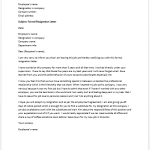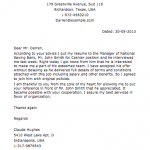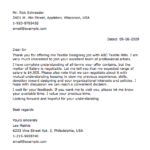Letters of transmittal are employed as distinguished forms of correspondence that introduce documents of some significance provided by one part to the other. These letters help in introducing the attached document, elaborating on its objective and providing any other additional information or directives when needed. Used in a business, law, education or information technology sector, these letters of transmittals help in enhancing corporate etic and ensuring specific instructions for transfer of documents.
What is a Letter of Transmittal?
Letters of transmittal are brief official letters addressed to define what is attached and why. They frequently specify the purpose of such correspondence, identify both the recipient and the sender and include any special procedures, time limits, or actions required. This letter is the instrument to overcome the gap between the sender’s motive and the understanding of the recipient to ensure that any material forwarded is considered in the appropriate setting.
There are several industries where letters of transmittal are a necessary component of the official documentation. They offer a track record of correspondence and show respect for the client as well as concern for small details. Through the inclusion of a concise statement of the function and the contents of the documents enclosed, the subject letters facilitate the making of decisions while avoiding misunderstanding. For instance, in areas like the technical and legal professions, a letter of transmittal which is another form of documentation, aids them in ensuring compliance to the rules, openness, and responsibility, because the process is a very delicate one. However, when such letters are written well, they improve the contents of the related elements and boost the client’s image of the one sending it altogether.
Purpose and Uses of Letters of Transmittal
Letters of transmittal refer to formal letters of communication in official circles that are used to introduce and explain the additional documents that are sent along with them. They are not mere cover letters, but rather functional instruments used to align expectations and control the discussion as relevant to the recipient’s understanding of the attached documentation. Most probably within an office or even other audiences, this is the type of document that provides systematic submission of documents without any chaos.
Contextualizing Accompanying Documents
One of the most important roles of a letter of transmittal is the explanation of the documents attached. Without making the recipient try to figure out the documents, the letter gives a short content about what are the documents about, why are they being sent and what role do such documents perform or and how are they supposed to be looked upon any recipient. This is very crucial especially where the documents are such as project reports, legal contracts, financial statements and the like, where information is either misunderstood or misplaced which causes costly damage.
Providing Summaries and Key Points
Letters of transmittal focus on the core areas of the documents they are sent along with. They include the main conclusions, results or affirmative steps, as the case may be, in order to orient the reader even before they get into the details. This enables those charged with making decisions to appreciate the significance of the document and determine which parts to go over first.
Establishing a Record of Document Submission
Letters of transmittal are also crucial in many aspects as they help one to establish an official documentation of the information conveyed. The written verification that the files have been returned is the indication of compliance with the process and may easily be allocated at such time when the need arises. For legal and organizational purposes, the said materials are required for record keeping, verification checks in terms of laws, regulations, policies, etc., and ensuring that people adhere to these.
Letters of transmittal fulfill all those functions effectively so that information can be relayed smoothly to facilitate proper and business-like interaction.
Free Sample Letters of Transmittal
Here are previews and download links for these sample letters,
Formatting Guidelines for Letters of Transmittal
The tone and content of the letter of transmittal should also reflect the professionalism of its format. A clearly formatted letter would allow the recipient to understand its intentions and add credibility to the sender. Properly structured, it becomes a formal and systematic communication that goes well with the documents it accompanies. Following all standard formatting guidelines guarantees that the letter will be obviously readable and follows business communication standards and visually is fitting to its audience.
Standard Business Letter Format
A letter of transmittal is normally composed according to the most generally accepted format, the standard block business letter. In this format all text is flush left, and there are no indentations. The letter should begin with the sender’s own contact information, followed by the date of writing, and then with the receiver’s full name, designation, company name, and address. A professional salutation would then lead toward the body of the letter, which must have a logical, well-organized flow of paragraphs. Closing statements must be formally structured; for example, “Sincerely” or “Regards.” The sign-off should always contain the sender’s name, title, and signature (if the letter is printed).
Font Selection and Spacing
The use of a credible, readable font is very critical. Fonts like Times New Roman, Arial, or Calibri in size 11 or 12 are effective for clarity. The letter should be single-spaced within paragraphs, but double spaced between them. There is enough white space to increase readability and so that the content does not appear crowded. Margins should be standard one inch on all sides which meet business correspondence standards.
Alignment and Paragraph Structure
The vast majority of business letters use left alignment, and all parts of the transmittal letter should likewise be left-aligned. In fact, a paragraph should say something like: what happened to the letter, a brief description of the content of the documents, and any instructions for the recipient. Avoid overly wordy text because it is hard to follow. Logical paragraph breaks should be used instead to assist in flow and understanding.
To ensure maximum clarity and professionalism, proper formatting anytime letters are sent with technical, legal, or business documents is imperative. The organization of a letter’s appearance improves communication with the audience and engenders amicable sentiments towards any further assessment of the documents enclosed.
Best Practices for Writing Letters of Transmittal
How to Write a Transmittal Letter If you think calling the document a key to the archives is enough to transmittal, you are wrong. Attention to tone, clarity, structure, and professionalism will go a long way in ensuring that the message gets across well. It is from best practices in writing that communication gets enhanced, and the letter is kept to fulfill its role as a guiding tool for what is enclosed.
Clarity and Conciseness
The transformation letter must be brief yet informative, providing its functionality through short notes. Use no jargon, no technical terms either, and construct the sentence in a way that confuses the reader. Instead, prefer common expression in the broadest sense, with care for the specific occasion, where the recipient does not have a complete familiarity with the whole text of the transmitted documents. A concise yet brilliant explanation of what is in the envelope, why it is sent, and what is to be done by the recipient puts some important context but does not tire him.
Maintaining a Professional Tone
The tone of the letter should remain formal and respectful, reflecting the seriousness of the exchange. Even if you are well acquainted with the recipient, a letter of transmittal is a professional document and should be treated as such. Maintain a courteous tone, use appropriate salutations and closings, and ensure that all names and titles are spelled correctly. A respectful tone reinforces the sender’s professionalism and contributes to a positive impression.
Personalizing Content for the Recipient
Customizing letters to the recipient’s identity, occupation, and the specific nature of the communication is important, even though templates can be useful. Using the recipient’s name, referencing previous encounters, or emphasizing common objectives or concerns shows consideration and helps build rapport. The more a letter is personalized, the less it will come across as boilerplate and more relevant to the specific addressee; hence, it becomes much more impactful and engaging.
Proofreading for Accuracy and Completeness
Grammatical errors, spelling mistakes, and format inconsistencies should be checked in a letter before sending it. Fine-tuning it brings out accuracy that demonstrates attention to detail and ensures that whatever the writer wishes to communicate is in fact conveyed. Checking whether actual attachments, contacts details, the tone, and the clarity of a message are included in the finalized steps of writing a professional and effective letter of transmittal.
When you apply these best practices, the letter of transmittal becomes a refined and strategic document that enhances the clarity, purpose, and professionalism of any formal submission.
Common Mistakes to Avoid
Though they appear deceptively simple, letters of transmittal are highly formal business documents requiring accuracy and clarity. Just a slight mistake in either writing or formatting can hurled professionalism of your communication or end in confusion for the recipient. It is always important for you to steer clear of such common mistakes to allow your letter to deliver the intended message and fulfill the purpose of the accompanying documents.
Omitting Essential Information
One of the most common mistakes is the failure of a letter to include all relevant details. A transmittal letter should clearly state what documents are included, the reason for submission, and any pertinent instructions or next steps that must be taken by the recipient. Without such context, the recipient may not correctly identify the materials in question and will thus be open to interpreting them in a number of ways with resultant delays. Always ensure that your letter answers the basic questions about what, why, and what next.
Using Overly Technical or Ambiguous Language
Another frequent mistake is using unnecessarily too technical, complex, or vague language. Although the supporting document may be technical, the letter of transmittal should serve as a clear, high-level summary. It should be written in simple language to enable even a non-technical audience to grasp its purpose. Using jargon or ambiguous terms without explanation makes the communication less effective and may confuse the recipient.
Neglecting to Specify Actions or Expectations
A transmittal letter should tell the recipient what is expected of them in terms of action, time frame, or response. Some writers, however, leave an unclear call to action, and then the recipient is left wondering what he should do next. Whether it is reading the document, signing and returning a form, or giving some feedback, it should be clearly laid out even, most importantly, in a polite manner to prompt swift action.
Failing to Include Contact Details
Accessibility in business correspondence is the key. Omitting either one’s contact information or providing no specification whose name should be invoked in case questions arise brings muddle to marshaling communication. Always state a name, phone number, and e-mail address in the last section so that the recipient knows how to contact you directly for any clarifications. This enhances the recipient’s experience, as he or she is able to work with you directly, and strengthens your commitment to open and professional communication.
Keep in touch for future updates on this topic to grab more free samples.













































